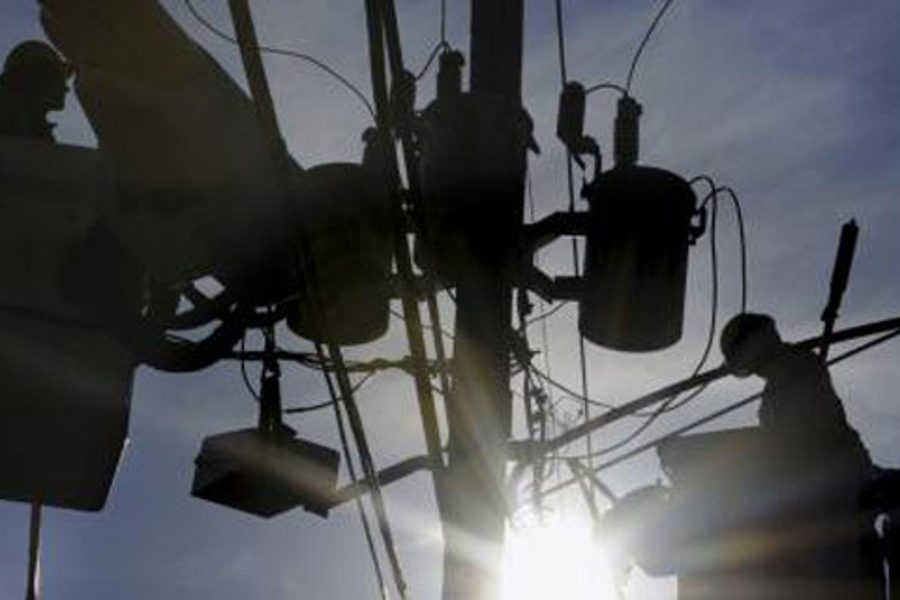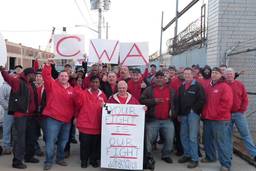Last month, Working In These Times examined how chronic understaffing at PEPCO led to power outages in the Washington, D.C.-area for as long as six days following a storm. Now union workers, members of the IBEW Local 457 and 420, which represent more than 1,000 workers at Connecticut Power & Light, are protesting what they feel are similar understaffing problems. On Tuesday, the union, which is in the midst of contract negotiations with Connecticut Light and Power and its parent company, Northeast Utilities, picketed the headquarters of Northeast Utilities in Hartford, Connecticut.
Last week, Connecticut’s Public Utility Regulatory Authority issued a report saying Connecticut Light and Power’s response to two major storms last fall that caused power outages was “deficient and inadequate.” The two storms caused 800,000 power outages each and many customers went without power for nearly a week. “It is clear that Northeast Utilities did not prepare for outages of this magnitude and did not build adequate capacity to respond,” Connecticut Governor Dannel Malloy said in response to the report.
Union officials say that a key reason why the outages lasted so long is understaffing. IBEW Local 457 Business Manager John Fernandes says the company put restrictions on the amount of overtime utility workers could work during the response to the two storms in order to keep costs low.
“At some of the municipal owned utilities that we represent, they do everything they need to get the lights back on and that philosophy has changed in the private sector,” Fernandes says. “Connecticut Light and Power restricted the hours of work to reduce the hours to get the labor costs while our municipality utilities were working 17 to 18 hours a day. We had two large storms, 800,000 people were without power, they were restricting overtime”.
Fernandes says that cost-cutting on labor extends throughout the business practices of Northeast Utilities. Despite paying its CEO $6.69 million in total compensation last year, Northeast Utilities is demanding that workers agree to massive healthcare concessions. The health care plan that Connecticut Light and Power is pushing its employees to agree to would increase their healthcare costs by 25% in its first year and with the potential for further increases in subsequent years.
The union also charges the company has not yet agreed to any type of serious staffing and attrition plan.
“They have reduced their staff by 30% or more in the last 15 years. Since the 1970s, it’s been reduced by half. There is some technological explanation, but that certainly doesn’t cover all that has occurred,” says Fernandes. “The majority of our guys are in their fifties. The amount of people that could potentially retire is huge and there is nobody in the pipeline. There is nobody currently being trained as helpers and we used to on a yearly basis have people being trained as helpers. Instead, they are hiring people from the contractors and the other utilities to come in when they need to for short term fixes. It’s not a long term fix to the problem.”
The union also claims that the company forces more and more of its workers to stay on call during their off days. This means that workers cannot travel more than a half-hour from their job sites, preventing many workers from taking vacations.
“It’s down to the point where on a very regular basis if there is the slightest threat of a storm, they are forcing 50-60% of the workforce to be on call. You can’t sustain that; it creates a lot pressure on families,” says Fernandes.
Northeast Utilities calls the union’s depiction of their business practices distorted.
“We think it’s unfortunate that the union leadership is using the media to distort the facts and mask the real issues,” Northeast Utilities spokesperson Caroline Pretyman says. “The main issues in the contracts are wages and medical insurance. We are working to address rising healthcare costs so we are asking the union to increase their contribution. In return we are offering to add jobs and increase wages.”
The union disputes that account. “I can tell you that conversation at the bargaining table never linked one to the other. Health care and staffing have been mutually exclusive issues,” says Fernandes.
“They want to hire 24 troubleshooters. It’s not like brining people in for the future,” adds Fernandes. “They want to bring people in for immediate needs, but that doesn’t address the needs for the future. They are no apprenticeship programs like in the past. We need to prepare for the future. This is a big issue with the workforce being mainly 50.”
When pressed to detail exactly what the company was offering at the bargaining table with regards to staffing, Pretyman said the company would not reveal specifics. “It’s part of the negotiating point,” Pretyman says. “We are still at the negotiating table.”
For now, the company and the union remain at the bargaining table. Though its contract expired on June 1, the union has continued to work without one, and has left the door open to strike. It’s unclear if the union will take that step if they are unable to reach an agreement with the company, but it does seem clear the union feels the current situation needs to change.
“It’s outrageous that CL&P continues to offer such unsafe and ineffective proposals on staffing at a time when the company remains under enormous scrutiny for poor storm response, and as it continues to fail the people of Connecticut with repeated power outages even now,” says Frank Cirillo, business manager of IBEW Local 420. “There’s a reason why CL&P and Yankee Gas can’t keep the lights on and the gas flowing. Rather than invest in work rules, infrastructure, equipment and adequate staffing, the companies choose to focus on profits.”









